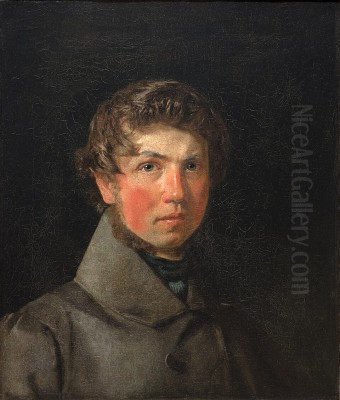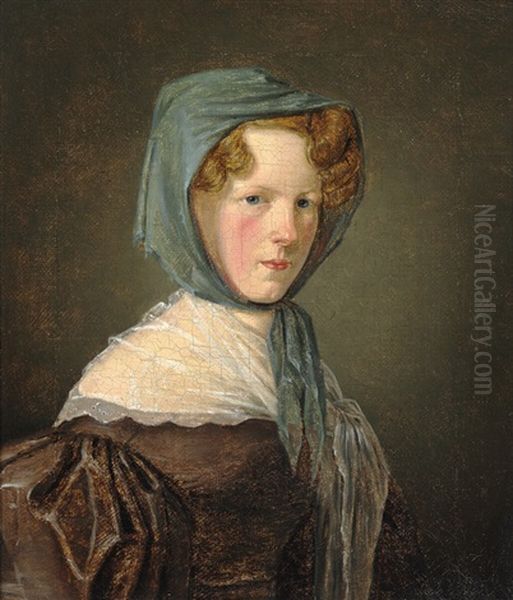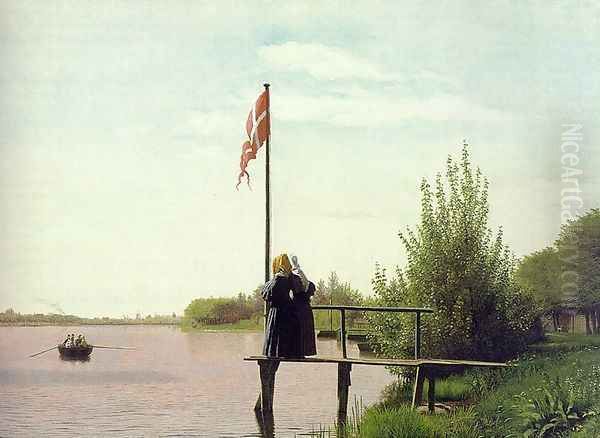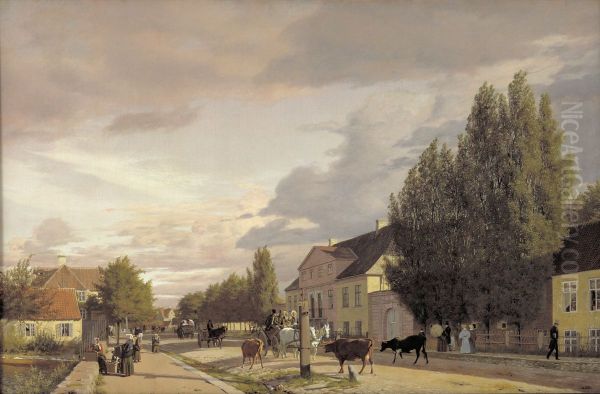
Christen Schjellerup Købke (1810-1848) stands as one of the most distinguished and beloved figures of the Danish Golden Age of painting. His relatively short life coincided with a remarkable flourishing of arts and sciences in Denmark, a period where the nation, despite political and economic hardships, forged a strong cultural identity. Købke, with his subtle yet profound observations of his immediate surroundings, his mastery of light, and his deeply personal approach to portraiture and landscape, contributed significantly to this era. His works, though often modest in scale and subject, radiate a quiet intensity and a timeless appeal that continue to resonate with audiences today.
Early Life and Artistic Awakening in Copenhagen
Christen Købke was born on May 26, 1810, in Copenhagen, into the family of Peter Berendt Købke, a master baker, and Cecilie Margrethe Købke. His upbringing in a craftsman's household, while not directly artistic, likely instilled in him a sense of diligence and attention to detail. The young Købke's path towards art was reportedly set in motion by a bout of rheumatic fever at the age of eleven. During his convalescence, he began to draw, discovering a passion and talent that would define his life.
Recognizing his burgeoning abilities, his family supported his artistic inclinations. In 1822, at the tender age of twelve, Købke was enrolled at the prestigious Royal Danish Academy of Fine Arts in Copenhagen. This institution was the crucible of the Danish Golden Age, shaping generations of artists who would define the nation's visual culture. Here, he would receive the foundational training that honed his natural talents.
The Guiding Hand of Eckersberg and Academic Foundations
At the Academy, Købke came under the tutelage of several influential figures, but none more so than Christoffer Wilhelm Eckersberg, often hailed as the "Father of Danish Painting." Eckersberg's impact on Købke, as on many of his contemporaries, was profound. Eckersberg championed a new approach to art, emphasizing direct observation of nature, meticulous study of perspective, and a clear, objective rendering of reality. He encouraged his students to paint outdoors (en plein air), capturing the fleeting effects of light and atmosphere.

Købke absorbed these lessons deeply. He learned to look at the world with a fresh, analytical eye, finding beauty and significance in the everyday. The academic environment also brought him into contact with a vibrant community of fellow students who would become prominent artists in their own right. Among them were figures like Wilhelm Bendz, a gifted portraitist and genre painter whose early death was a loss to Danish art; Constantin Hansen, known for his historical paintings and Italian scenes; Jørgen Roed, another fine portraitist and architectural painter; and the versatile Wilhelm Marstrand, who excelled in genre scenes, historical subjects, and portraits. This circle of artists, often studying and working closely together, fostered an environment of mutual learning and artistic exploration. Other notable contemporaries from Eckersberg's school included Martinus Rørbye, known for his travel scenes, and Ditlev Blunck.
Themes and Subjects: A Celebration of Danish Life
Købke's art is characterized by its intimate focus on his immediate surroundings. He rarely ventured into grand historical or mythological themes, preferring instead to find his subjects in the familiar landscapes, architecture, and people of Copenhagen and its environs. His family's home, first in the Citadel (Kastellet) and later on Blegdamsvej, provided a rich source of inspiration.
His landscapes often depict the tranquil outskirts of the city, the serene lakes, and the distinctive Danish light. He painted views of Østerbro, the area around the Sortedam Lake, and the fortifications of Copenhagen. These were not dramatic, sublime vistas in the Romantic tradition of artists like Caspar David Friedrich, but rather quiet, contemplative scenes imbued with a sense of peace and order. He was particularly adept at capturing the subtle shifts in light and atmosphere at different times of day, lending his landscapes a remarkable sense of presence.
Portraiture was another significant aspect of Købke's oeuvre. He painted numerous portraits of family members, friends, and fellow artists. These portraits are notable for their psychological insight and their unpretentious naturalism. He approached his sitters with empathy and a keen eye for individual character, avoiding flattery or idealization. His depictions of children, in particular, are rendered with a tender sensitivity.
Architectural studies also feature prominently in his work. He was fascinated by the play of light on surfaces, the textures of brick and stone, and the geometric forms of buildings. Churches, castles, and ordinary dwellings were all rendered with a meticulous attention to detail and a strong sense of structure.
A Master of Light and Atmosphere
Perhaps the most defining characteristic of Christen Købke's art is his extraordinary sensitivity to light and atmosphere. He possessed an almost unparalleled ability to capture the nuanced qualities of Danish light – its clarity, its softness, its way of suffusing a scene with a gentle radiance. Whether depicting the bright sun of a summer afternoon, the cool light of morning, or the warm glow of an evening sky, Købke's handling of light is always precise and evocative.

His paintings often seem to breathe with a palpable sense of atmosphere. He masterfully rendered the effects of air and distance, creating a convincing illusion of depth and space. This was achieved not through dramatic chiaroscuro, but through subtle gradations of tone and color, and a keen understanding of aerial perspective. His skies are never mere backdrops; they are active components of the composition, alive with light and cloud formations that contribute to the overall mood of the piece. This focus on light and atmosphere connects him to a broader European tradition, including Dutch 17th-century masters like Johannes Vermeer, though Købke’s vision remained distinctly Danish.
Key Works: Windows into Købke's World
Købke's body of work, though not vast due to his short life, contains numerous masterpieces that exemplify his unique vision.
One of his most iconic early works is "View from a Window in the Citadel, Copenhagen" (1833). This painting, likely depicting a view from his family's apartment, is a study in quiet observation. The composition is simple yet elegant, with the window frame providing a structuring element. Through the window, a glimpse of the masts of ships and the calm waters of the harbor can be seen, bathed in a soft, diffused light. The painting evokes a sense of domestic tranquility and a connection to the wider world beyond.
His portraiture is exemplified by works such as "Portrait of P. Ryder, the Artist's Cousin's Son" (c. 1832-33). The young boy is depicted with a direct, engaging gaze, his personality captured with warmth and insight. Købke’s ability to connect with his sitters, especially children, is evident here. Similarly, "Portrait of Margrethe Hahne" (1833) showcases his skill in rendering character and texture, with the sitter's lace collar and thoughtful expression meticulously detailed.
Landscapes like "View of Lake Sortedam" (1838) demonstrate his mastery of atmospheric effects. The calm surface of the lake reflects the sky, and the scene is imbued with a serene, almost meditative quality. The careful rendering of the trees and the distant shoreline showcases his commitment to Eckersberg's principles of direct observation. Another significant landscape is "Frederiksborg Castle in the Evening Light" (1835), where the historic castle is bathed in the warm, golden hues of sunset, creating a scene of romantic beauty tempered by realistic detail.
"View of Aarhus Cathedral" (1829), an earlier work, already shows his interest in architectural subjects and his ability to handle complex perspectives. The imposing structure of the cathedral is rendered with precision, and the play of light on its surfaces is carefully observed.

His depictions of his family's surroundings, such as "A Corner of the Artist's Father's House on Blegdamsvej" (c. 1833) or later works from the Blegdam area, are intimate and personal. These paintings often focus on seemingly mundane details – a section of a wall, a doorway, a garden path – but Købke elevates them through his sensitive handling of light and his ability to find beauty in the ordinary. "The Artist's Sister, Conradine Købke" (1832) is a tender portrait that captures a familial bond with honesty and affection.
A particularly ambitious work, "The Return of Bertel Thorvaldsen to Copenhagen in 1838" (study, c. 1838-39), depicts the celebrated Danish sculptor Bertel Thorvaldsen's triumphant homecoming. While Købke was not primarily a painter of large historical events, this study shows his ability to handle complex multi-figure compositions and capture a moment of national significance.
The Italian Sojourn: A Journey of Exploration
Like many artists of his generation, Købke felt the allure of Italy, the historical heartland of classical and Renaissance art. In 1838, he received a travel stipend from the Academy and embarked on a journey south, visiting Germany before spending time in Rome, Naples, and Capri from 1839 to 1840. This was a period of intense study and sketching.
In Italy, he encountered a different quality of light, a more dramatic landscape, and a rich artistic heritage. He produced numerous studies and paintings of Italian scenes, including views of Capri and Pompeii. He also interacted with other artists in Rome, including the Danish decorative painter Georg Hilker, who became a friend.
However, Købke's Italian works, while accomplished, are generally not considered to possess the same unique power and intimacy as his Danish scenes. The brilliant Mediterranean light and the grandeur of the Italian landscape seemed, in some ways, less suited to his particular sensibility, which thrived on the more subtle and familiar beauty of his homeland. Upon his return to Denmark, he largely reverted to his Danish subjects, suggesting that his artistic heart truly lay in the north. His Italian experience, nonetheless, broadened his horizons and likely reinforced his appreciation for the unique qualities of his native environment.
Challenges, Recognition, and Untimely End
Despite his evident talent and the quality of his work, Christen Købke did not achieve widespread fame or significant financial success during his lifetime. He applied for membership to the Royal Danish Academy of Fine Arts on two occasions, in 1836 and again in 1846 with a painting of the Blegdamsvej bakery, but was unsuccessful both times. This may have been due to a variety of factors, including academic politics or a prevailing taste that sometimes favored more overtly dramatic or historically themed art.
He continued to paint, focusing on his familiar subjects and undertaking some decorative commissions, including work at the Thorvaldsen Museum alongside other artists like Constantin Hansen and Jørgen Sonne. He also maintained close friendships with fellow artists, notably the landscape painter Frederik Sødring, with whom he shared a studio for a time.
Tragically, Christen Købke's life was cut short. He contracted pneumonia (or possibly tuberculosis, sources vary) and died on February 7, 1848, at the age of just 37. He was buried in Assistens Cemetery in Copenhagen, a resting place for many of Denmark's most illustrious figures, including Hans Christian Andersen and Søren Kierkegaard.
It was only after his death that Købke's true stature began to be fully appreciated. Art historians and critics, looking back at the Golden Age, recognized the exceptional quality of his work, his innovative approach to light and composition, and the profound sincerity of his vision. His paintings, once modestly valued, became highly sought after.
The Enduring Legacy of Christen Købke
Christen Købke is now universally regarded as one of the central figures of the Danish Golden Age. His influence, though perhaps not immediately apparent in a direct lineage of followers, lies in the enduring power of his artistic vision. He demonstrated that profound art could be created from the simplest of subjects, and that the careful observation of one's own environment could yield works of universal appeal.
His mastery of light and atmosphere set a standard for Danish landscape painting and influenced subsequent generations of artists. While later movements like the Skagen Painters (such as P.S. Krøyer and Michael Ancher) developed their own distinct styles, the preoccupation with capturing the unique qualities of Danish light can be seen as a continuation of a tradition to which Købke contributed significantly. Even later artists like Vilhelm Hammershøi, with his quiet, light-filled interiors, share a certain Danish sensibility for atmosphere and introspection that echoes Købke's work, albeit in a different stylistic language.
Købke's emphasis on the "unremarkable" and the everyday, finding beauty in his immediate surroundings, prefigured aspects of later Realist and Impressionist concerns, though he remained firmly rooted in the Golden Age aesthetic. His friend, the artist and illustrator Lorenz Fröhlich, praised Købke's extraordinary ability to capture the essence of his subjects with profound insight and truthfulness.
Købke's Works in Collections and Exhibitions
Today, Christen Købke's paintings are treasured possessions of Danish and international museums. The largest and most significant collection of his work is held at the Statens Museum for Kunst (SMK - The National Gallery of Denmark) in Copenhagen, which houses approximately 61 of his paintings, representing about a fifth of his total known oil paintings. Key works here include "View from a Window in the Citadel, Copenhagen," "Portrait of P. Ryder, the Artist's Cousin's Son," and many of his iconic landscapes and portraits.
The Hirschsprung Collection in Copenhagen also boasts an important selection of Købke's art, including the luminous "View of Østerbro in Morning Light" (Parti af Østerbro i morgenbelysning). The Ny Carlsberg Glyptotek and local Danish museums also hold examples of his work. The Museum of National History at Frederiksborg Castle is home to his study for "The Return of Bertel Thorvaldsen."
Internationally, Købke's work can be found in collections such as the Nationalmuseum in Stockholm, which owns sketches like the "Portrait of the Sculptor Stephan Peter Johannes Hjort Ussing" and the charming children's portrait "Carl von Nutzhorn."
His art has been the subject of major retrospective exhibitions, which have helped to solidify his reputation outside of Scandinavia. A notable exhibition, "Christen Købke: Danish Master of Light," was held at the Scottish National Gallery in Edinburgh in 2010, and subsequently at the National Gallery in London, introducing his work to a wider British audience. His paintings have also been included in broader surveys of Danish Golden Age art, such as an exhibition at the Metropolitan Museum of Art in New York in 2016.
Conclusion: A Quiet Radiance
Christen Købke's art is a testament to the power of quiet observation and sincere expression. In his relatively brief career, he created a body of work that captures the essence of the Danish Golden Age – its intimacy, its clarity, and its deep connection to the national landscape and character. He was a painter who found the universal in the particular, transforming everyday scenes and familiar faces into timeless images of beauty and truth. His paintings continue to invite contemplation, drawing viewers into a world suffused with a gentle, luminous light – the quiet radiance of a truly exceptional artist. His legacy is not one of dramatic gestures or revolutionary manifestos, but of a profound and enduring artistic integrity that secures his place among the masters of 19th-century European painting.